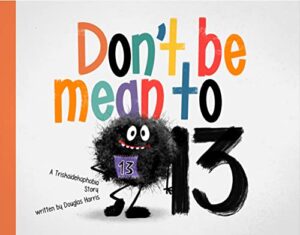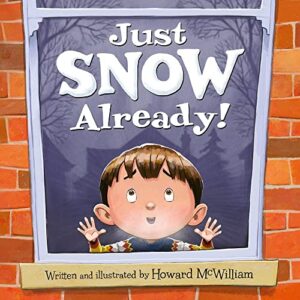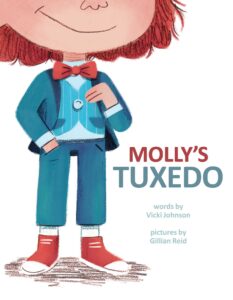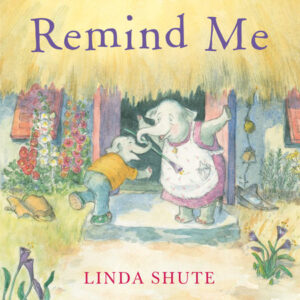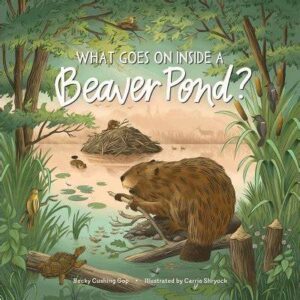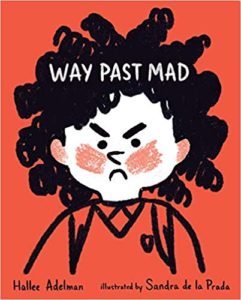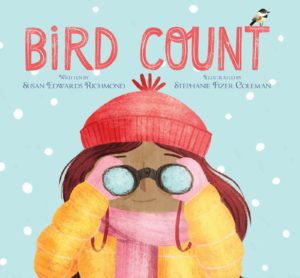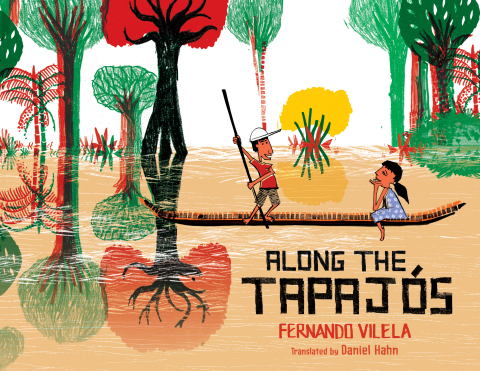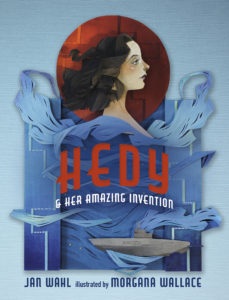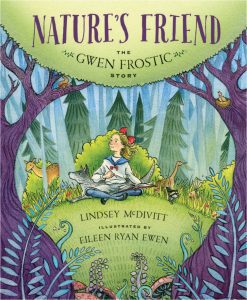–Ryan’s Review of the Writing–
Author/illustrator Fernando Vilela’s Along the Tapajós tells the story of Cauã and Inaê, a brother and sister who live in a small village along Brazil’s Tapajós River. (Here’s a map and more information about the river, in case you want a fuller geographical context for this story.) While all of their homes are up on stilts, the rainy season brings so much water that the entire community relocates to higher, drier ground. When they get to their new temporary home, the kids realize the problem straight away–they forgot their pet tortoise, Titi. A tortoise isn’t a turtle, so he can’t swim to safety on his own (turtles can swim whereas tortoises can’t). The pair hatch a daring plan to sneak back at night on a journey along the river to rescue him. Will they be able to save Titi in time before the waters get too high?
Foreign words won’t prove daunting here. Other than the names, there’s only one in the entire story, and it’s well-glossed within the text. (Pa always finds a good spot, someplace sunny and close to an igarapé–that’s a kind of waterway.)
Readers will surely enjoy comparing the world of these kids to their own–the stilt houses, the school only reached by boat, the big critters (alligators and anacondas) lurking in the water, the idea of a two-season year, a community-wide annual migration, etc. All of that might lead to interesting discussions for sure.
The ending of this story, however, is potentially troublesome. Once the kids realize that Titi has been left behind, they disobey their parents who specifically tell them NOT to go back for the pet. And while on this unapproved rescue mission, they encounter an anaconda who’s about to gobble up the tortoise and both kids. But doesn’t. Why? It’s an unexplained deus ex machina moment. (“I don’t know how it happens, but when I jump back into the boat with Titi in my arms, the queen of the jungle gets all tangled up!”) Lucky for the kids and Titi, sure, but that’s the thing–they win via luck, not through their own efforts. Taken together, those two story moments might not sit well with readers.
Still, the book offers a lot of vivid details about this community that are interesting and extremely well-depicted, visually speaking. And the backmatter, too, is quite fascinating and full of compelling facts, details, and images. The real selling point of this book, though, is the pictures. See what Linda has to rave about below!
3.75 out of 5 pencils
–Linda’s Review of the Illustrations–
The art in Fernando Vilela’s Along the Tapajós snags the eye and enlarges the interpretive experience of American children. It is a textured panorama reflecting the energy of its creation and the urgency of the story it tells. The marks are slashed, carved, and incised, the palette basic–mostly flat tones of greens, browns, red and yellow on an armature of black. The effect is of layered, hand-printed folk art. The river is a gouged wood block printed edge to edge across the pages, over and under other elements. Palm fronds, lily pads, oxen, fish, birds, the snake’s pattern, and the catwalk supports are stamped on freely. The pages are filled with details authentic to the cultural setting and invite reexamination and discovery.
The figures, however, are drawn, and the sister and mother wear flowered collaged dresses. Their black outlines are angular and sometimes crude. The faces are appropriately simple but expressive cartoons. The only stylistic distraction for me was a capybara pair that seemed Photoshopped additives.
Although the viewpoint voice is the boy’s, the book’s visual main character is the tan river which dominates virtually every page. The double spread riverside landscape might backdrop two or three sequential actions of the boat and children, an ingenious design maneuver to avoid fracturing the flowing scene. The river carries the action forward, the villagers to their winter refuge, and finally transforms the world we first entered. When the children return to rescue their tortoise from their now-submerged home, they find the land structure and water creatures dreamily melded. The closing endpaper, a rainy season redux of the opening dry season endpaper, brings us to a satisfying and thought-provoking full circle.
5 out of 5 crayons


